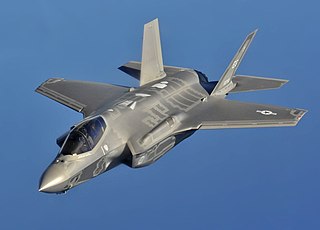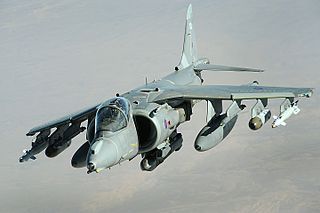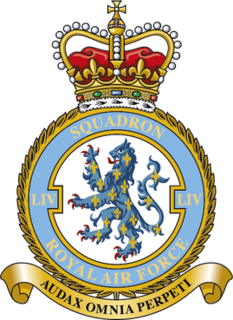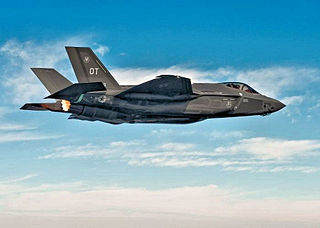Operational Evaluation Unit
Last updatedAn Operational Evaluation Unit is a type of "reserve" squadron of the Royal Air Force. OEU squadrons are tasked with evaluating an aircraft's weapons, systems and performance. This is to either assist in bringing the aircraft to an operational capability, or to continually assess how to best utilize the aircraft's capability once its in service. An example of such a squadron is No. 17 Squadron of the RAF. The Squadron's role as the F-35B Operation Evaluation Unit is being tasked with introducing the JSF aircraft into service with the Royal Air Force. [1] It is equipped with four F35Bs and currently operates from Edwards Air Force Base in the United States. [2]
Contents
Current OEUs
- F-35B Lightning Joint Strike Fighter
- Typhoon & Tornado Force
- 41(R) Squadron RAF - Test and Evaluation Squadron
- ISTAR Force
- Transport Force
- Joint Helicopter Command Operational Evaluation Unit
Previous OEUs
- AgustaWestland AW101 Merlin
- 700 Naval Air Squadron - 2000 to 2008.
- Strike Attack OEU - to 2004
- F3 OEU
- Air Guided Weapons OEU - to 2004
- Fast Jet & Weapons Operational Evaluation Unit. -2206 to 2010
See also
Related Research Articles

The Lockheed Martin F-35 Lightning II is an American family of single-seat, single-engine, all-weather stealth multirole combat aircraft that is intended to perform both air superiority and strike missions. It is also able to provide electronic warfare and intelligence, surveillance, and reconnaissance capabilities. Lockheed Martin is the prime F-35 contractor, with principal partners Northrop Grumman and BAE Systems. The aircraft has three main variants: the conventional takeoff and landing (CTOL) F-35A, the short take-off and vertical-landing (STOVL) F-35B, and the carrier-based (CV/CATOBAR) F-35C.

The Royal Air Force (RAF) is the United Kingdom's air and space force. It was formed towards the end of the First World War on 1 April 1918, becoming the first independent air force in the world, by regrouping the Royal Flying Corps (RFC) and the Royal Naval Air Service (RNAS). Following the Allied victory over the Central Powers in 1918, the RAF emerged as the largest air force in the world at the time. Since its formation, the RAF has taken a significant role in British military history. In particular, it played a large part in the Second World War where it fought its most famous campaign, the Battle of Britain.

The Fleet Air Arm (FAA) is one of the five fighting arms of the Royal Navy and is responsible for the delivery of naval air power both from land and at sea. The Fleet Air Arm operates the F-35 Lightning II for maritime strike, the AW159 Wildcat and AW101 Merlin for commando and anti-submarine warfare and the BAE Hawk as an aggressor.

The Eurofighter Typhoon is a European multinational twin-engine, canard delta wing, multirole fighter. The Typhoon was designed originally as an air superiority fighter and is manufactured by a consortium of Airbus, BAE Systems and Leonardo that conducts the majority of the project through a joint holding company, Eurofighter Jagdflugzeug GmbH. The NATO Eurofighter and Tornado Management Agency, representing the UK, Germany, Italy and Spain, manages the project and is the prime customer.

Number 17 Squadron, currently No. 17 Test and Evaluation Squadron (TES), is a squadron of the Royal Air Force. It was reformed on 12 April 2013 at Edwards Air Force Base, California, as the Operational Evaluation Unit (OEU) for the Lockheed Martin F-35B Lightning.

Royal Air Force Coningsby or RAF Coningsby, is a Royal Air Force (RAF) station located 13.7 kilometres (8.5 mi) south-west of Horncastle, and 15.8 kilometres (9.8 mi) north-west of Boston, in the East Lindsey district of Lincolnshire, England. It is a Main Operating Base of the RAF and home to three front-line Eurofighter Typhoon FGR4 units, No. 3 Squadron, No. 11 Squadron and No. 12 Squadron. In support of front-line units, No. 29 Squadron is the Typhoon Operational Conversion Unit and No. 41 Squadron is the Typhoon Operational Evaluation Unit. Coningsby is also the home of the Battle of Britain Memorial Flight (BBMF) which operates a variety of historic RAF aircraft.

Joint Force Harrier, initially known as Joint Force 2000 and towards the end of its life as Joint Strike Wing, was the British military formation which controlled the British Aerospace Harrier II and British Aerospace Sea Harrier aircraft of the Royal Air Force and Fleet Air Arm between 2000 and 2011. It was subordinate to RAF Air Command.

The British Aerospace Harrier II is a second-generation vertical/short takeoff and landing (V/STOL) jet aircraft used previously by the Royal Air Force (RAF) and, between 2006 and 2010, the Royal Navy (RN). The aircraft was the latest development of the Harrier Jump Jet family, and was derived from the McDonnell Douglas AV-8B Harrier II. Initial deliveries of the Harrier II were designated in service as Harrier GR5; subsequently upgraded airframes were redesignated accordingly as GR7 and GR9.

The Eurofighter Typhoon is in service with seven nations: United Kingdom, Germany, Italy, Spain, Saudi Arabia, Oman and Austria. It has been ordered by Kuwait and Qatar, with orders for all eight customers still pending as of September 2017. The aircraft has, as of 2016, been provided in a basic air-defense form and has been upgraded to newer production standards which include internal IRST, air-to-ground precision strike capability, and HMSS helmets. Most of the major systems including the CAPTOR radar and the Defence Aids Sub-System (DASS) are expected to be improved and updated over time, with the radar being updated to an AESA, being the CAPTOR-E/CAESAR, of which the Kuwait Air Force will be the inaugural operator, with first deliveries of their 28 new-built aircraft to commence in 2019.

Number 15 Squadron, sometimes written as No. XV Squadron, was a squadron of the Royal Air Force. It most recently operated the Panavia Tornado GR4 from RAF Lossiemouth as No. XV (Reserve) Squadron. It was the RAF's Operational Conversion Unit for the Tornado GR4 which taught pilots and Weapon Systems Officers (WSO) how to fly the aircraft and what tactics to use to best exploit the performance of their aircraft and its weapons.

Number 54 Squadron is a squadron of the Royal Air Force based at RAF Waddington, Lincolnshire. On 1 September 2005, it took on the role of Intelligence, Surveillance and Reconnaissance (ISR) Operational Conversion Unit, and is currently responsible for training all RAF crews assigned to the MQ-9A Reaper, Shadow R1/R2, RC-135W Rivet Joint and Poseidon MRA1. It also controls the RAF ISR Warfare School (ISRWS) who run the Qualified Weapons Instructor Intelligence, Surveillance and Reconnaissance and QWI Reaper Courses.

The Royal Australian Air Force's Air Combat Group (ACG) is the group which administers the RAAF's fighter and bomber aircraft. ACG was formed on 7 February 2002 by merging the RAAF's Tactical Fighter Group and Strike Reconnaissance Group in an attempt to improve the speed with which the RAAF can deploy its combat aircraft. The current commander of ACG is Air Commodore Anthony Grady.
The planning for the future of the Royal Air Force involves supporting ongoing British military operations, the introduction of new aircraft types, greater focus on network enabled capability and increasing interoperability with members of NATO.

The Air and Space Warfare Centre (AWSC) is a Royal Air Force research and testing organisation based at RAF Waddington in Lincolnshire. It has a training branch nearby as a lodger unit of RAF Cranwell and other branches elsewhere, including at RAF High Wycombe, RAF Brize Norton, MoD Boscombe Down, and RAF Odiham.

The 422d Test and Evaluation Squadron is a United States Air Force unit. It is assigned to the 53d Test and Evaluation Group, stationed at Nellis Air Force Base, Nevada. The squadron performs operational testing of all fighter aircraft and munitions entering and in operational use by Air Combat Command.

The General Dynamics F-111K was a planned variant of the General Dynamics F-111 Aardvark medium-range interdictor and tactical strike aircraft by General Dynamics, to meet a requirement for such an aircraft for the Royal Air Force.
At the end of the Cold War in 1989 the Royal Air Force structure was as follows:

The Lightning Force HQ was the organisation controlling the operations of the Lockheed Martin F-35B Lightning aircraft of the Fleet Air Arm and Royal Air Force. Following on from the principles developed in the operation of the UK's previous STOVL aircraft, the Harrier, the formation is a joint organisation falling under RAF Air Command.
The Strike Attack Operational Evaluation Unit (SAOEU) or Strike Attack OEU, was a unit of the Royal Air Force based at RAF Boscombe Down in Wiltshire between 1988 and 2004. The unit operated the Panavia Tornado GR1 and GR4, BAE Harrier and SEPECAT Jaguar aircraft. The role of the SAOEU was to evaluate new and existing equipment and to develop fast-jet ground attack tactics in order to provide timely advice to the front line.
References
- ↑ http://94.236.30.48/rafconingsby/aboutus/17reservesquadron.cfm
- ↑ "17(R) Squadron". raf.mod.uk. Royal Air Force. Archived from the original on 28 October 2016. Retrieved 19 November 2015.
Text is available under the CC BY-SA 4.0 license; additional terms may apply.
Images, videos and audio are available under their respective licenses.